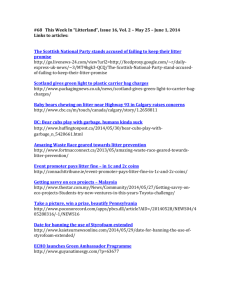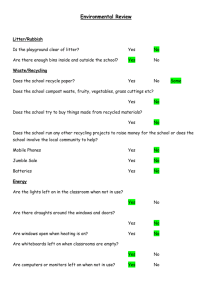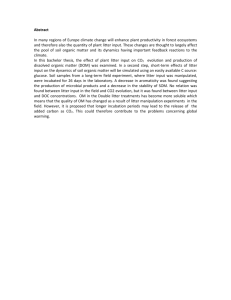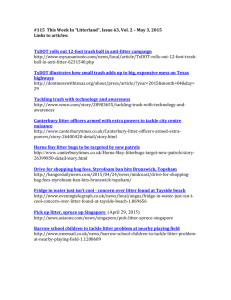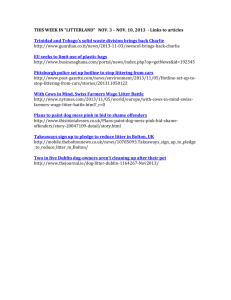Bottom-Up Influences in Vernal Pools
advertisement
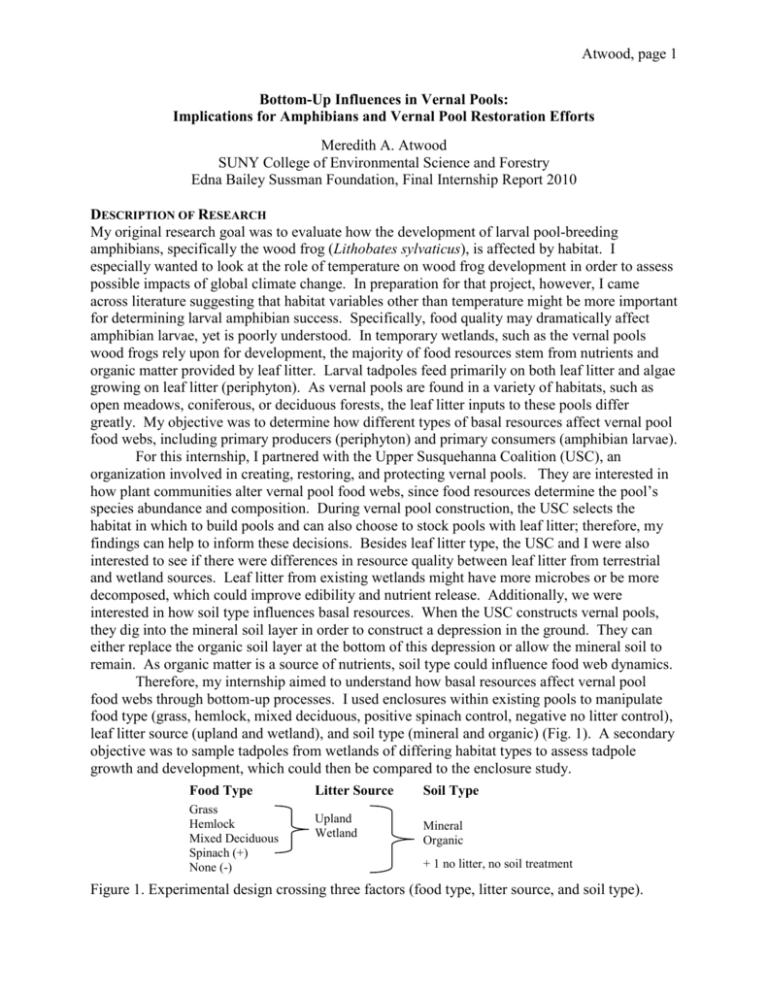
Atwood, page 1 Bottom-Up Influences in Vernal Pools: Implications for Amphibians and Vernal Pool Restoration Efforts Meredith A. Atwood SUNY College of Environmental Science and Forestry Edna Bailey Sussman Foundation, Final Internship Report 2010 DESCRIPTION OF RESEARCH My original research goal was to evaluate how the development of larval pool-breeding amphibians, specifically the wood frog (Lithobates sylvaticus), is affected by habitat. I especially wanted to look at the role of temperature on wood frog development in order to assess possible impacts of global climate change. In preparation for that project, however, I came across literature suggesting that habitat variables other than temperature might be more important for determining larval amphibian success. Specifically, food quality may dramatically affect amphibian larvae, yet is poorly understood. In temporary wetlands, such as the vernal pools wood frogs rely upon for development, the majority of food resources stem from nutrients and organic matter provided by leaf litter. Larval tadpoles feed primarily on both leaf litter and algae growing on leaf litter (periphyton). As vernal pools are found in a variety of habitats, such as open meadows, coniferous, or deciduous forests, the leaf litter inputs to these pools differ greatly. My objective was to determine how different types of basal resources affect vernal pool food webs, including primary producers (periphyton) and primary consumers (amphibian larvae). For this internship, I partnered with the Upper Susquehanna Coalition (USC), an organization involved in creating, restoring, and protecting vernal pools. They are interested in how plant communities alter vernal pool food webs, since food resources determine the pool’s species abundance and composition. During vernal pool construction, the USC selects the habitat in which to build pools and can also choose to stock pools with leaf litter; therefore, my findings can help to inform these decisions. Besides leaf litter type, the USC and I were also interested to see if there were differences in resource quality between leaf litter from terrestrial and wetland sources. Leaf litter from existing wetlands might have more microbes or be more decomposed, which could improve edibility and nutrient release. Additionally, we were interested in how soil type influences basal resources. When the USC constructs vernal pools, they dig into the mineral soil layer in order to construct a depression in the ground. They can either replace the organic soil layer at the bottom of this depression or allow the mineral soil to remain. As organic matter is a source of nutrients, soil type could influence food web dynamics. Therefore, my internship aimed to understand how basal resources affect vernal pool food webs through bottom-up processes. I used enclosures within existing pools to manipulate food type (grass, hemlock, mixed deciduous, positive spinach control, negative no litter control), leaf litter source (upland and wetland), and soil type (mineral and organic) (Fig. 1). A secondary objective was to sample tadpoles from wetlands of differing habitat types to assess tadpole growth and development, which could then be compared to the enclosure study. Food Type Grass Hemlock Mixed Deciduous Spinach (+) None (-) Litter Source Upland Wetland Soil Type Mineral Organic + 1 no litter, no soil treatment Figure 1. Experimental design crossing three factors (food type, litter source, and soil type). Atwood, page 2 NARRATIVE OF WORK COMPLETED In April 2010, I began my study. Crossing my three experimental factors (Fig. 1) yielded 17 treatments, which I replicated in a block design across three wetlands. I collected leaf litter, soil, and wood frog egg masses from wetlands in Tully, New York. I collected about 50-100 embryos from eight egg masses from four selected wetlands to ensure genetic diversity. Upon hatching, I randomly selected three tadpoles from each wetland to be placed in each enclosure so that each enclosure was stocked with a total of 12 tadpoles, a density approximating field conditions. From April to mid-July, I sampled tadpoles for survivorship, mass, and developmental stage. Upon metamorphosis, individuals were removed from the study and final mass was recorded. In addition to measuring tadpole parameters, I also measured periphyton biomass to see the influence of basal resources on primary producers. I placed three ceramic tiles within each enclosure in mesh bags that precluded tadpole grazing. At the conclusion of the study, I removed all tiles, scraped them clean of algae, and followed standard protocols to measure the level of chlorophyll a (a proxy for algal biomass). Additionally, twice during the study (May 28 and June 11) I measured water quality parameters, including temperature, chlorophyll a, conductivity, dissolved oxygen, pH, and turbidity. I also had temperature loggers in a subsample of three enclosures per pool (12 enclosures total) that continuously measured temperature over the course of the entire study. Lastly, I identified three reference sites of differing terrestrial habitats (grasses, mixed deciduous, and hemlock/mixed deciduous mixture). At each site, I placed temperature loggers and ceramic tiles to measure periphyton biomass. I also sampled sites for tadpoles to measure growth and development to compare to enclosure studies. Unfortunately, I was unable to sample enough tadpoles to make comparisons, and I had to drop this portion of my research. PRELIMINARY RESULTS Basal Resources To assess the quality of basal resources, I want to assess the carbon (C), nitrogen (N), and phosphorus (P) levels of both the soil and leaf litter. Both N and P can be limiting in aquatic systems and algal biomass depends on the availability of both nutrients. The lower the C:N or C:P ratio, the more nutrients available. The C:N ratios of my litter samples were lowest (most nutritious) for my positive spinach control, followed by mixed deciduous, grasses, and hemlock, respectively (Fig. 2). I do not yet have results for the soil or for P. 80 70 C:N Ratio 60 a 50 40 30 ab bc c c 20 10 Grass Hemlock Mixed_Deciduous Spinach d 0 Upland Wetland Figure 2. C:N ratio of leaf litter. The lower the C:N, the more nutrients should be available. Atwood, page 3 Primary Producers (Periphyton) For primary producers, there was no effect of the three natural litter types, litter source, or soil type. The spinach and no leaf litter treatments had higher periphyton biomass (p≤0.10 for hemlock and mixed deciduous; p<0.05 for grass; Fig. 3). 0.3 b b Chl a / cm2 0.25 a* 0.2 a* 0.15 a 0.1 0.05 0 Grass Hemlock Deciduous None Spinach Figure 3. Periphyton biomass across the five food type treatments. Primary Consumers (Wood Frog Larvae) For tadpole survivorship, there was no effect of leaf litter source (p=0.575). Survivorship was higher in organic soil for hemlock treatments and no litter treatments (p<0.05). There was no difference in survivorship between natural litter types (grasses, hemlock, and mixed deciduous) (p>0.05). Survivorship was similar between spinach and no litter treatments in organic soil, but was significantly higher for spinach treatments in mineral soil (interaction, p=0.157) (Fig. 4). 100% a ab 80% ab Survivorship ab Grass 60% 40% 20% abc bc Hemlock None c Spinach Mixed_Deciduous c 0% Mineral Organic None Figure 4. Survivorship of wood frog tadpoles across food and soil treatments. For mass at metamorphosis, there were no significant differences by litter source or soil type. Tadpole mass was highest in spinach controls, lowest in no litter controls, and intermediate in the three litter types (p<0.05). For time to metamorphosis, there were no significant differences between the natural litter treatments. Tadpoles in the no litter treatments had slightly faster metamorphosis compared to tadpoles in the grass (p=0.123), hemlock (p=0.131), or mixed deciduous (p=0.069) treatments. Tadpoles in the spinach controls in organic soil had the fastest development, which yielded significant interactive effects between soil and litter type (p<0.20) (Fig. 5). Time to Metamorphosis (Days) Atwood, page 4 56 54 b 52 50 48 b b ab ab ab a Grass Hemlock Mixed_Deciduous None Spinach 46 44 Mineral Organic None Figure 5. Time to metamorphosis for wood frog tadpoles across food and soil treatments. PRELIMINARY CONCLUSIONS Litter source (wetland vs. upland) did not significantly affect either primary producers or primary consumers. Mineral soils led to lower tadpole survivorship, but slightly faster tadpole development than organic soils. This could be due to mineral soils physically harming tadpoles or providing poorer quality or quantity of food resources than organic soil. Litter type does not seem to drive vernal pool food webs; however, periphyton may be very influential. It is possible that leaf litter prohibits algal growth, which should be evaluated further. The results suggest tadpoles are resource-limited, as tadpoles in the spinach controls had high survivorship, fast development, and were largest. Therefore, leaf litter inputs to vernal pools have the potential to negatively influence amphibian development, while inputs of organic soil positively influence development. Vernal pool restoration efforts should consider food web dynamics by using organic soil and maximizing periphyton abundance. FUTURE WORK Analyze soil samples for C, N, P, and aluminum (Al). Al could physically harm developing tadpoles, which may explain the high mortality in mineral soil treatments. Analyze leaf litter samples for P. Chemical allelopathy study, which will assess if leaf litter prohibits algal growth. Analyze intermediary tadpole length, mass, and development measurements. Produce a final report to the USC and present my findings to their staff. PRESENTATIONS I have presented my findings at two conferences thus far, including the Northeastern Partnership in Amphibian and Reptile Conservation annual meeting in August and the Student Conference on Conservation Science (SCCS) in November. Both meetings provided me with feedback on my work and networking opportunities. At SCCS, I was awarded one of the Best Poster awards. ACKNOWLEDGMENTS I am grateful to my advisor Dr. James Gibbs, committee member Dr. Kimberly Schulz, and USC sponsor Melissa Yearick for helping to make this project a success. I thank the Edna Bailey Sussman Foundation for supporting this research and making it possible. The Foundation has been, and will continue to be, acknowledged on all publications and presentations. Atwood, page 5 PICTURES One of three wetlands where enclosures were located. Me taking tadpole measurements in the field. Tadpoles being processed in the field (counted, weighed, staged, and photographed). Me sifting through enclosures to find tadpoles for measurements. Me with my poster at the Northeastern Partnership in Amphibian and Reptile Conservation annual meeting, August 2010. Recent wood frog metamorphs.
